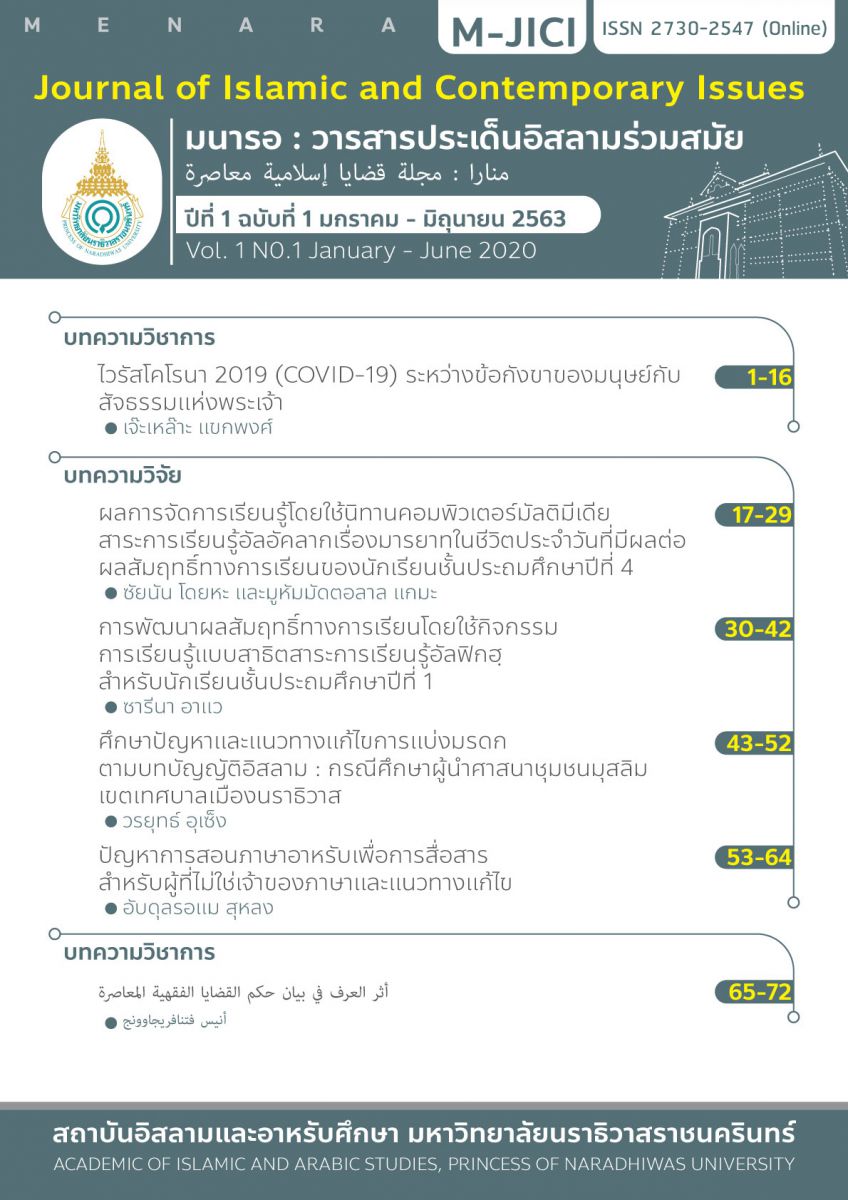Results of Learning Management by Using Multimedia Storytelling on al-Akhlaq Subject in Daily Manners Affecting the Learning Achievement of Primary School Students, Year 4
Keywords:
learning management, multimedia storytelling, learning on al-Akhlaq subject, learning achievementAbstract
This research is quantitative research with the objectives of to 1) develop and find efficiency of multimedia storytelling on al-Akhlaq Subject in daily manners for the primary school students, year 4 to be effective according to the criteria, 2) to compare student leaning achievement by using multimedia storytelling on al-Akhlaq subject in daily manners for primary school students, year 4 before and after the classes and, 3) to assess student satisfaction towards the learning on al-Akhlaq subject by using multimedia storytelling on al-Akhlaq subject for primary school students, year 4. In this research, the researcher collect data by, 1) one hour 40 multiple-choice pre-test using the achievement test before learning al-Akhlaq subject created by the researcher, 2) manage 8 plans by 2 hours each for al-Akhlaq subject teaching and learning activities by using multimedia storytelling of primary school, year 4, 3) one hour post-test by using the same analytical ability test as the pre-test, 4) Using a questionnaire for students' satisfaction with learning and understanding of morals, ethics, and knowledge by using multimedia storytelling on al-Akhlaq subject for the primary school students, year 4 for the students’ comments by answering the satisfaction questionnaire as created by the researcher. The sample group used in this research is 19 primary school students, year 4 of Ban Nibong School, Kabang Sub-District, Kabang District, Yala Province, for the semester 1 of 2019 academic year by easy random.
Research tools 1) Learning management Storytelling on al-Akhlaq Subject by using multimedia storytelling, 2) Learning achievement form and 3) student satisfaction towards the learning on al-Akhlaq subject by using multimedia storytelling on al-Akhlaq subject for primary school students, year 4 by 1) develop and find efficiency of multimedia storytelling on al-Akhlaq Subject in daily manners for the primary school students, year 4 before and after the class according to 80/80 criteria by using E1/E2 value), 2) to compare student leaning achievement by using Independent t-test, 3) to assess student satisfaction towards the learning on al-Akhlaq subject by using multimedia storytelling on al-Akhlaq subject for primary school students, year 4 by using percentage and mean. The research found that, 1) the efficiency of multimedia storytelling on al-Akhlaq Subject in daily manners for the primary school students, year 4 is 82.04/86.58, 2) learning achievement of the students on al-Akhlaq Subject in daily manners by using multimedia storytelling on al-Akhlaq subject for primary school students, year 4 after the class higher than before the class in the statistical mean of .01 and 3) student satisfaction towards the learning on al-Akhlaq subject by using multimedia storytelling on al-Akhlaq subject for primary school students, year 4 is in very good scale.
References
กระทรวงศึกษาธิการ. (2545). พระราชบัญญัติการศึกษาแห่งชาติ พ.ศ. 2542 และที่แก้ไขเพิ่มเติม (ฉบับที่ 2) พ.ศ. 2545. กรุงเทพฯ: องค์การรับส่งสินค้าและพัสดุภัณฑ์ศึกษาธิการ.
กระทรวงศึกษาธิการ. (2551). หลักสูตรแกนกลางการศึกษาขั้นพื้นฐาน พุทธศักราช 2551. กรุงเทพฯ: ชุมนุมสหกรณ์การเกษตรแห่งประเทศไทย.
กระทรวงศึกษาธิการ. (2551). หลักสูตรแกนกลางการศึกษาขั้นพื้นฐาน พุทธศักราช 2551. กรุงเทพฯ: ชุมนุมสหกรณ์การเกษตรแห่งประเทศไทย.
กระทรวงศึกษาธิการ. (2551). หลักสูตรอิสลามศึกษา ตามหลักสูตรแกนกลางการศึกษาขั้นพื้นฐานพุทธศักราช 2551. กรุงเทพฯ: คุรุสภาลาดพร้าว.
เกริก ยุ้นพันธ์. (2539). การเล่านิทาน. พิมพ์ครั้งที่ 2. กรุงเทพฯ: สุวีริยาสาสน์.
ขจิต ศรีมีชัย. (2550). การพัฒนาบทเรียนคอมพิวเตอร์มัลติมีเดียโดยใช้การ์ตูนประกอบการอ่านนิทานอีสป วิชาภาษาอังกฤษ สำหรับนักเรียนช่วงชั้นที่ 3. สารนิพนธ์ กศ.ม. เทคโนโลยีการศึกษา บัณฑิตวิทยาลัย มหาวิทยาลัยศรีนครินทรวิโรฒ.
จิณัฐตา อารามพระ. (2553). การเปรียบเทียบผลสัมฤทธิ์ทางการเรียนและความคิดสรางสรรค เรื่องการสร้างภาพหรือชิ้นงานจากจินตนาการโดยใช้โปรแกรมกราฟกดวยบทเรียนคอมพิวเตอร มัลติมิเดียมีรูปแบบบทเรียนแตกต่างกันของนักเรียนชั้นประถมศึกษาปีที่ 4. (วิทยานิพนธ์ปริญญามหาบัณฑิต) มหาวิทยาลัยมหาสารคาม.
บุญชม ศรีสะอาด. (2546). การวิจัยเบื้องต้น. พิมพ์ครั้งที่ 7. กรุงเทพฯ: สุวีริยาสาส์.
เบญจา แสงมลิ. (2545). การพัฒนาเด็กปฐมวัย. กรุงเทพฯ: เมธีทิปส์.
เผชิญ กิจระการ. (2544). การวิเคราะห์ประสิทธิภาพสื่อและเทคโนโลยีเพื่อการศึกษา E1 /E2. วารสารการวัดผลการศึกษามหาวิทยาลัยมหาสารคาม, 7(2), 44-52.
ลาณี เลิศอุดมกิจไพศาล. (2544). Authorware 6. กรุงเทพฯ: SPC Book.
วาโร เพ็งสวัสด์. (2551). วิธีวิทยาการวิจัย. กรุงเทพฯ: สุวีริยาสาสน์.
สนิท สัตโยภาส. (2547). นวัตกรรมการศึกษาชุดการวิจัยเพื่อพัฒนาการเรียนรู้และพัฒนาผลงานทางวิชาการเรื่องบูรณาการการสอนการสร้างหนังสือสำหรับเด็ก. กรุงเทพฯ: ธารอักษร.
สุคนธ์ สินธพานนท์. (2551). นวัตกรรมการเรียนการสอนเพื่อพัฒนาคุณภาพของเยาวชน. กรุงเทพฯ: ห้างหุ้นส่วนจำกัด 9119 เทคนิคพริ้นติ้ง.
สุพรรณษา ครุฑเงิน. (2555). การสร้างและพัฒนาสื่อมัลติมีเดียเพื่อการเรียนรูดวยตนเอง เรื่องขอมูลสารสนเทศ สำหรับนักเรียนชั้นมัธยมศึกษาปที่ 1. (วิทยานิพนธปริญญามหาบัณฑิต) มหาวิทยาลัยเทคโนโลยีราชมงคลธัญบุรี.
สุรศักดิ์ ปาเฮ. (2537). การเลือกและใช้สื่อการสอนอย่างมีประสิทธิภาพ. วารสารประชาศึกษา, 45(3), 27-30.
อติพร ปานพุ่ม และวงกต ศรีอุไร. (2557). การพัฒนาสื่อมัลติมีเดียแบบมีปฏิสัมพันธ์เรื่องการทดลอง วิทยาศาสตร์บนระบบปฏิบัติการแอนดรอยด์สำหรับนักเรียนชั้นประถมศึกษาปีที่ 2. ประชุมวิชาการระดับชาติด้านคอมพิวเตอร์และเทคโนโลยีสารสนเทศ ครั้งที่ 10 (NCCIT2014).
อรัญญา เพิ่มพีรพัฒน์. (2548). การศึกษาความสามารถทางภาษาของเด็กปฐมวัยที่ใช้นิทานพื้นบ้านเป็น สื่อเสริมประสบการณ์. (วิทยานิพนธ์ครุศาสตรมหาบัณฑิต) หลักสูตรและการสอน มหาวิทยาลัยราชภัฏนครราชสีมา.
อินทิรา รุมาส. (2545). การใช้กิจกรรมเล่านิทานเพื่อพัฒนาคุณลักษณะทางคุณธรรม จริยธรรม สำหรับนักเรียนชั้นอนุบาลที่2. เชียงใหม่: บัณฑิตวิทยาลัย มหาวิทยาลัยเชียงใหม่.
อิบรอฮีม ณรงค์รักษาเขต. (2552). ประวัติการศึกษาอิสลาม. หาดใหญ่: หาดใหญ่กราฟฟิก.



